Click to Skip Ahead
Few pets draw such a myriad mix of reactions than a snake, and the White Lipped Python is among the most impressive.
They have a ferocious appearance, a massive size, and a temperamental attitude. But if you’re up for a challenge and want an impressive pet, they can be a great choice.

Quick Facts About the White Lipped Python
| Species Name: | Leiopython albertisii |
| Common Name: | White Lipped Python |
| Care Level: | High |
| Lifespan: | 30 years |
| Adult Size: | 6’ to 7’ |
| Diet: | Mice and rats |
| Minimum Tank Size: | 4’ by 3’ by 2’ |
| Temperature and Humidity: | 85-90-degree Fahrenheit tank: 95-degree Fahrenheit heat lamp, humidity between 75% and 90% |
Do White Lipped Pythons Make Good Pets?
While many people dislike the idea of having a snake for a pet, if you’re an adventurous reptile owner, a White Lipped Python might be just the challenge that you’ve been looking for.
However, if you’re looking for a pet to handle and hang out with, a White Lipped Python probably isn’t a good choice. These snakes are notorious for biting and extremely defensive. Paired with their 6–7-foot size, if you don’t know what you’re doing, you can get into trouble quickly.
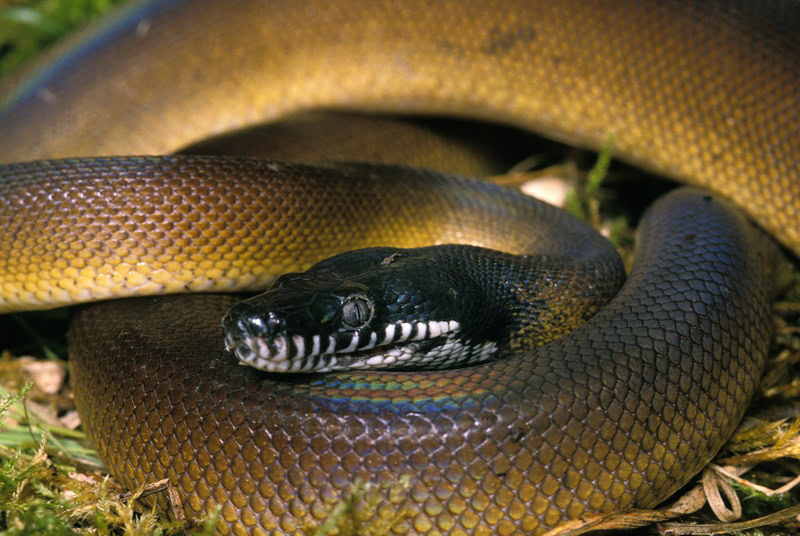
Appearance
There are two main types of White Lipped Pythons: Northern White Lipped Pythons and Southern White Lipped Pythons.
Northern White Lipped Pythons have a dark-colored head and a dark brown to black color. Their underbody is a cream color in sharp contrast to the rest of their body.
Southern White Lipped Pythons, on the other hand, are duller in color. They typically have a uniform brown or gray appearance that gets lighter around the sides of the snake. They also have a cream-colored underbody.
Both types have white scales around their mouth, which is the reason for their “White Lipped” name.

How to Take Care of White Lipped Pythons
Habitat, Tank Conditions & Setup
Tank
While a 4’ x 3’ x 2’ is the minimum tank size for a White Lipped Python, we recommend something even larger, preferably about 5’ long and 3’ wide. You’ll need to do a deep clean on the cage at least once a month, but be ready to spot-clean the cage as needed.
You can also keep live plants in the enclosure with your snake, as long as the tank is big enough. Just keep in mind that this might require you to up the cleaning a bit.
Lighting
You need to avoid direct sunlight with your snake enclosure. Direct sunlight can cause your cage to overheat and kill your White Lipped Python.
Heating (Temperature and Humidity)
Keeping your enclosure at the correct temperature is a critical part of caring for a White Lipped Python. Cooler parts of the enclosure should be kept at 85 degrees Fahrenheit, while an area under a heat lamp needs to be at least 95 degrees Fahrenheit.
At night, the tank can cool a bit, but it should never dip below 75 degrees. Keeping temperatures too cool can cause your snake to regurgitate, which can lead to more problems.
You also need to keep humidity extremely high in the enclosure. You need to mist daily to keep the humidity levels between 75% and 90%. While this is always important, it’s even more important when your snake is shedding.
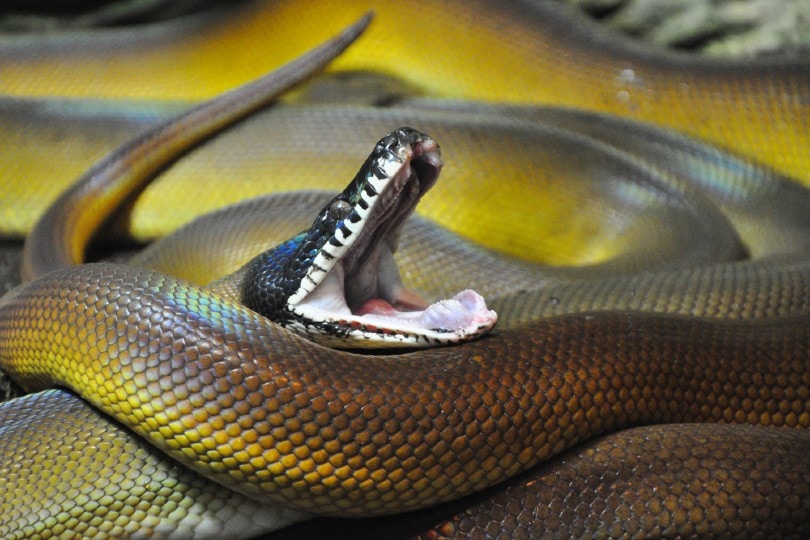
Substrate
There are a few different choices for your substrate, but one of the most important factors is how well it holds humidity. That’s why we recommend something along the lines of coconut fiber, organic topsoil, sphagnum moss, cypress mulch, bark, or coconut bark. Your best option is to have a mix of these materials spread out throughout the tank.
Tank Recommendations
| Tank Type: | 5’ x 3’ x 2’ preferred |
| Lighting: | Avoid direct sunlight |
| Heating: | A heat lamp at 95 degrees Fahrenheit, and an area of the tank that cools to 85 degrees Fahrenheit. Never let it get below 75 degrees Fahrenheit, even at night. Maintain high humidity, between 75% and 90%. |
| Best Substrate: | A mix of coconut bark, organic topsoil, and cypress mulch |
Feeding Your White Lipped Python
While White Lipped Pythons in the wild have a diverse diet of whatever small mammals they can find, in captivity, these snakes can move to a much simpler diet of mice and rats. They don’t need a diverse diet, so as long as you give them appropriate-sized mice and rats, you’ll be good to go.
For juvenile White Lipped Pythons, stick with mice and feed them once to twice a week. When your White Lipped Python is an adult, you can stick to feeding them a single rat every 7 to 10 days.
Keep in mind that White Lipped Pythons will cough up hairballs of the mammals that they eat, so don’t be surprised if your Python does this occasionally. Also, when your White Lipped Python is preparing to shed, expect that they won’t eat for a few days.
Do not add rodents during this time because they injure and even kill your White Lipped Python while they are vulnerable.
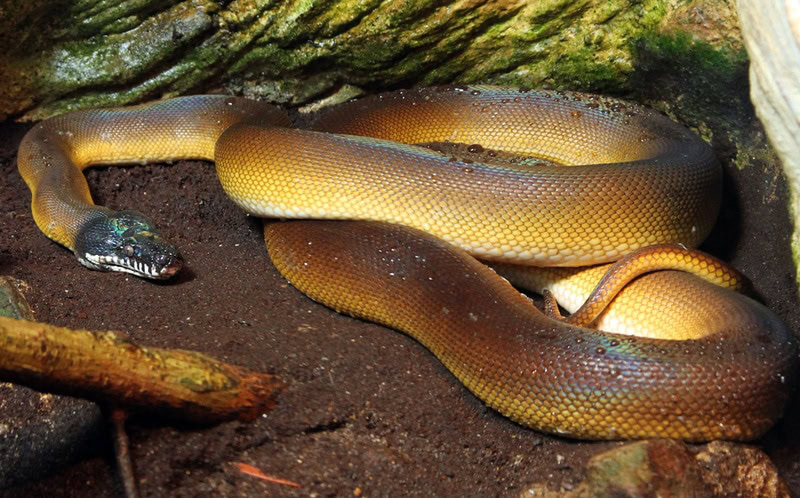
Diet Summary
| Food type: | Mice and rats |
| Percent of Diet: | 100% |
Keeping Your White Lipped Python Healthy
White Lipped Pythons rarely have health concerns when you take care of them properly. However, like all captive snakes, there are a few things that you need to look out for. Parasites, scale rot, respiratory infections, and obesity can occur, especially if conditions are not ideal.
If your snake does get sick, we recommend consulting a vet who excels in exotic animals. You’ll also need to address the concern that likely got them sick in the first place. For example, there might not be enough humidity, the tank is dirty, or you overfed them.
Common Health Issues
These include parasites, scale rot, respiratory infection, and obesity.
Lifespan
When properly cared for, White Lipped Pythons have an extremely long lifespan. It’s not uncommon for these snakes to live up to 30 years, so be sure you’ll be able to take care of them for their entire life before purchasing one.
Also, keep in mind that this includes trips and vacations since these snakes are not easy for inexperienced hands to take care of.
Breeding
There are few animals as tricky to breed as the White Lipped Python. Both the male and female need to be compatible and you won’t know if your pair is compatible until they’re in the cage together. Closely related Pythons tend to never breed.
If you do get a compatible pair, they’ll hit sexual maturity after 4 to 5 years. Then the female will go through a gestation period of 3 months before laying anywhere from three to 20 eggs.
The eggs take 2 months to hatch and will take another 4 to 5 years to reach full maturity. However, they are completely independent from birth.
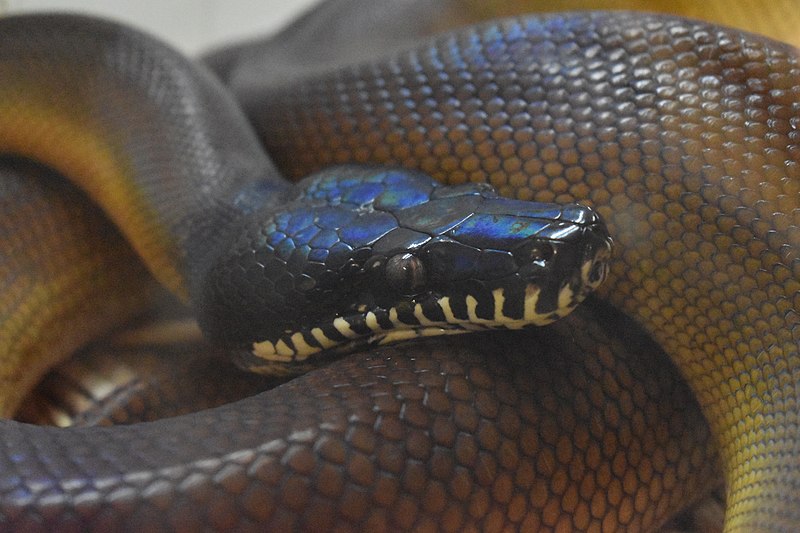
Are White Lipped Pythons Friendly? Our Handling Advice
White Lipped Pythons are among the least friendly snakes on the planet. While White Lipped Pythons brought up in captivity are a little less hostile and defensive, they’re still extremely aggressive.
Because of this, you need to invest in a snake hook to remove them from their enclosure. While these snakes are defensive and nippy, you will need to handle them to tame them a bit. Always wash your hands thoroughly before handling them, so you don’t smell like prey.
Allow the snake to move freely around you. Start with short sessions before slowly extending the time. Never attempt to squeeze, grip, or otherwise restrain your White Lipped Python while they’re on you, as this will make them more defensive and increase the likelihood that they will bite.
Shedding & Brumation: What to Expect
White Lipped Pythons shed their skin a few times a year, and when they’re getting ready to do so, they’ll start the process quickly, so don’t add any rodents at this point. Moreover, a White Lipped Python should shed their skin all at once; if they don’t, it means there’s not enough humidity in the enclosure.
When it comes to brumation, it’s not something that you should have to worry about with a White Lipped Python. In their wild habitat, winter temperatures are almost identical to summer temperatures, so they’re not used to a difference or any changes.
How Much Do White Lipped Pythons Cost?
Considering how difficult a White Lipped Python is to breed, their $300 to $400 cost is incredibly affordable. Since these snakes live up to 30 years, it’s not a bad price.
However, when you factor in their extremely large cage, heat lamps, food, and more, you can easily expect to spend $2,000 to $3,000 in the first year.

Care Guide Summary
- Large and impressive snake
- Extremely long lifespan
- They need few cage cleanings
- Defensive and nippy
- Expensive upfront cost
- They require an experienced hand to care for them
Final Thoughts
The White Lipped Python is a bit temperamental, but it’s nothing that an experienced snake keeper can’t handle. The result is an impressive snake that could be the highlight of your collection.
Just be sure to get everything that you need before you make your purchase because the last thing you want is more snake than you can handle!
Related Reads:
Ghost Ball Python Morph: Facts, Pictures, Appearance & Care Guide
Featured Image Credit: Sriyana, Shutterstock
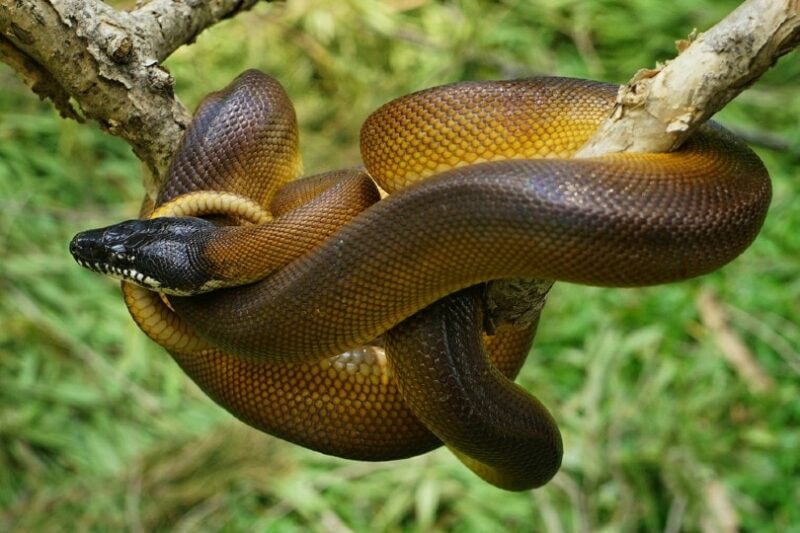





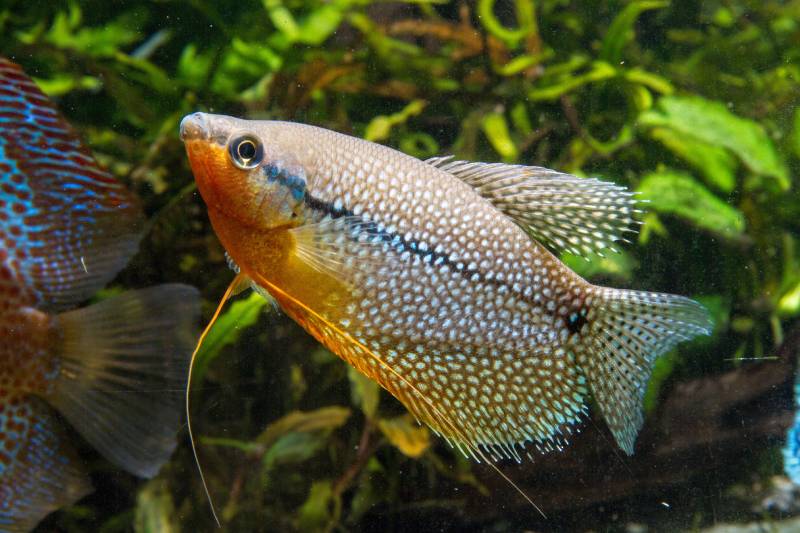
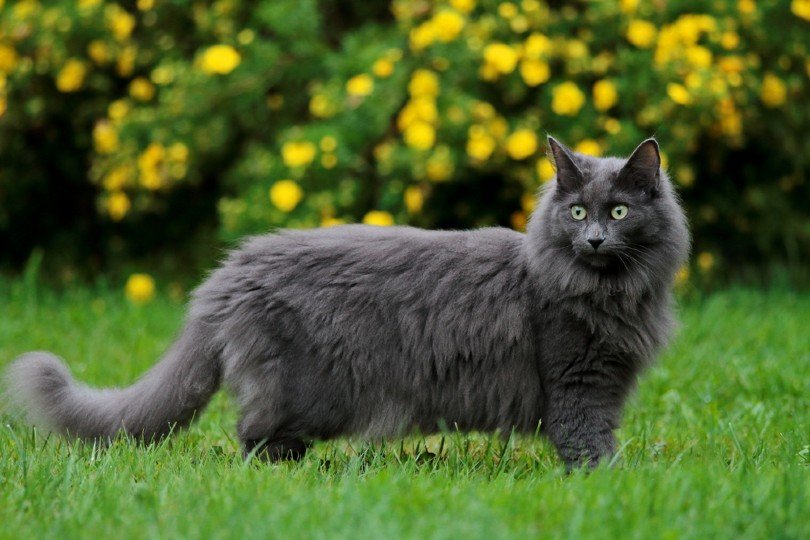
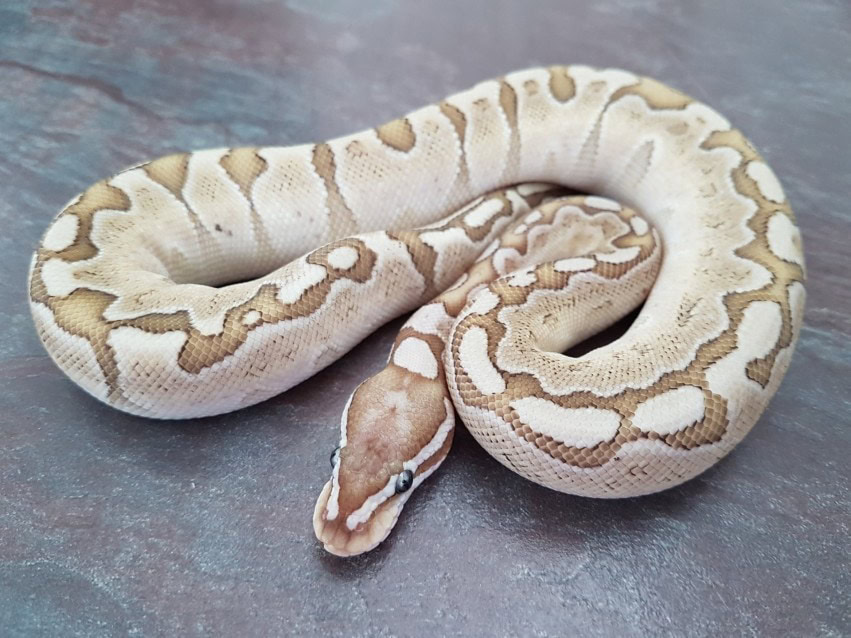


2 Responses
I am looking for any genetic information studies on the post-ocular markings that are behind the eyes of NWLP’s. They appear to be identical on both the right and left sides of the same snake yet different from snake to snake (NWLP). For my study I would need many DNA’s to compare, let alone even so many pictures. So I am looking for breeders that I can talk with to compare the features between clutches of siblings with photos of them & their parents for my Masters Thetis.
I have had 3 NWLP; 1 for 24 years she was 29 years old when she died, now I have 1.1 pair of 3 year olds.
please any addition contact information would be helpful
Hello Mark,
thank you for your comment. Unfortunately, we are not in touch with any White-Lipped Python breeders, but we would like to suggest to visit our post: Best Ball Python Breeders – Reviews & Top Picks. It could be a great starting point with your search. Best of luck with your Master Thesis!